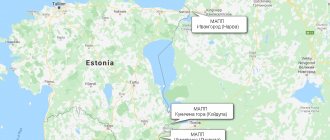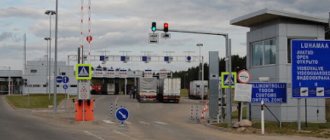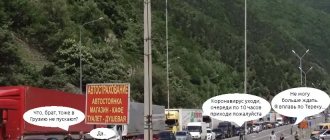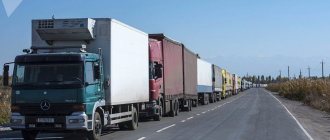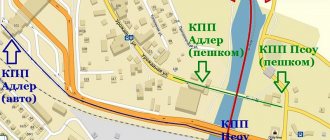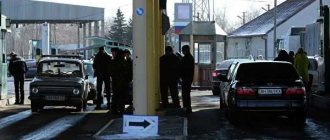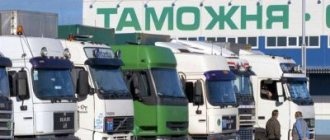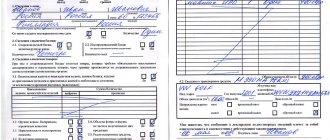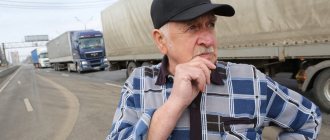There are many advantages to traveling around Estonia by car on your own. However, you need to prepare for such a trip in advance - in addition to choosing a hotel and route, you should familiarize yourself with the procedure for crossing the border with Estonia. Usually, no difficulties arise, but some get lost, for example, when faced with the need to pre-book a time to cross the border with Estonia - at all three checkpoints between the states, you must pre-select the time of departure from Estonia to Russia.
In addition, it is important to remember the rules for the import and export of certain goods, familiarize yourself with the prices for fuel and parking services in advance, and make sure that there is a sufficient amount of money in your account.
Documents required to cross the Russian-Estonian border by car
To cross the Russian-Estonian border in your car, you must present the following minimum package of documents at the border crossing point:
1. A foreign passport valid for at least six months after the planned return from Estonia.
2. Valid Schengen visa. Estonian Schengen can be obtained from the Estonian Embassy in Moscow (Maly Kislovsky lane, 5, www.estemb.ru, e-mail :
), in the consular departments of Estonia in
St. Petersburg (Bolshaya Monetnaya, no. 14, www.peterburg.estemb.ru, e-mail :
) and
Pskov (Narodnaya, no. 25, e-mail: [email protected] ).
In order to enter Estonia, it is absolutely not necessary to present an Estonian visa to the border guards - a multi-Schengen visa from any country that is part of the Schengen agreement is also suitable. Moreover, if, for example, you received a multi-Schengen visa at the French Embassy, there is absolutely no point in trying to first go to France, and only then to other European countries. Absolutely legally, with such a visa you can go first, for example, to Estonia or somewhere else, and only then to France. In this case, the main thing is that you have at least one French stamp on this visa, confirming that you were in France after all and it was not for nothing that they issued you their visa. 3. If you are traveling with children, you will need to present the child’s birth certificate at the Russian-Estonian border. If a child is traveling without one of the parents, a notarized power of attorney will be needed for the responsible person to have the right to travel with the child outside the Russian Federation.
4. International vehicle insurance (the so-called “green card”). You can purchase it from most large insurance companies; for a period of 14 days for a passenger car it will cost about 2,500 rubles (for the summer of 2021). By the way, if you forgot to purchase a “green card” before your trip, you can do this already at the entrance to the border: just look carefully around, the closer you are to the checkpoint, the more often you will come across kiosks with signs “insurance”, “Schengen insurance” and the like. The only downside in this case will be that you will have to choose from the list of companies with which these cross-border insurance brokers cooperate.
5. Medical insurance with insurance coverage of at least 30 thousand euros is the standard insurance required to obtain a Schengen visa from any of the countries included in the agreement. At the border, people often don’t ask for medical insurance, but according to the rules they must do so - so it is very advisable to have it with you.
6. International driving license and national driving license. MVO at the border is also often not required, but since Estonia has signed the Convention on Road Traffic, they may well do so. Obtaining an international driver's license is not difficult: to do this, you just need to obtain the necessary medical certificates, take photographs, contact the authorized MREO at your place of residence, fill out an application and pay the state fee; Unlike the national driving license, the MVO is issued for a period of 3 years (but its validity cannot exceed the validity of your national license).
Requirements for a car when crossing the border between Russia and Estonia
First of all, the car must be technically sound and have readable license plates in accordance with legal requirements. Also, border guards often pay attention to the condition of the glass and headlights: the glass should not have cracks (at least the windshield in the driver’s line of sight) - Poles and, to a lesser extent, Finns are considered especially scrupulous in this matter. For the Balts, I didn’t notice any particular desire to find fault with the condition of the car, but it’s still better to put it in order before the trip. EU border officials have a very negative attitude towards any “radar detectors” and “video recorders” - so it is better to keep them away while crossing the border. As for the age of the car: there are no restrictions on age (unlike, for example, Azerbaijan) and environmental friendliness of the exhaust on the Russian-Estonian border, the main thing is that black smoke does not come out of the exhaust pipe. In exceptional cases, border crossing staff can check the CO content in the exhaust - but I have never encountered this. Regarding the additional equipment required to cross the border between Russia and Estonia: as far as I know, there is no clear list and the opinions of “experienced” people vary greatly, so I will give my version, formed after numerous trips by car to the countries of the European Union and Transcaucasia. Some of this list may seem superfluous to the reader, but there is always a possibility that some particularly zealous employee will decide to get to the bottom of something you are missing and thus ruin the start of your long-awaited vacation.
List of additional vehicle equipment for crossing the Russian-Estonian border:
Fire extinguisher RUS sticker on the trunk lid First aid kit according to TUV standards Warning triangle Tow rope Reflective vest Not necessary, but highly recommended on a long journey: A full set of tools for minor repairs Full-size spare tire Metal canister for fuel Pump Wheel wrench Jack Wire for “lighting” Wheel chocks shoes” – 2 pcs. (regarding the “shoes” - I came across information on the Internet that Estonian border guards check for them when crossing the border. I won’t lie, I’ve never been asked - but I take them with me just in case).
Where to cross the border between Russia and Estonia
At the moment, three land border crossing points between Russia and Estonia are open: “Ivangorod - Narva” , “Kunichina Gora - Koidula” , “Shumilkino - Luhamaa” . Let's take a closer look at them.
The main and, importantly, the busiest checkpoint is considered to be the Ivangorod-Narva ; travelers from St. Petersburg and the Russian North-West in general, as well as Muscovites who want to get to Tallinn along the shortest possible route, usually travel through it to Estonia.
The checkpoint on the Russian-Estonian border “Shumilkino - Luhamaa” is mainly preferred by those who: a) are traveling to South Estonia b) are traveling to Tallinn or the islands of Hiiumaa and Saaremaa, but want to avoid standing in hours-long traffic jams at the border and c) are traveling in transit through the territory of Estonia to Latvia and generally to the southern Baltic.
In terms of workload, the point “Ivangorod - Narva” is followed by “Shumilkino - Luhamaa” , and the third is “Kunichina Gora - Koidula” . For example, in July 2021, the situation with queues (for cars) on the Russian-Estonian border was as follows: “Ivangorod - Narva”: 5 hours or more “Kunichina Gora - Koidula”: 1 hour “Shumilkino - Luhamaa”: 2 hours
All three Estonian-Russian border crossing points operate 24 hours a day.
How to get to checkpoints across the Russian-Estonian border
International checkpoint “Ivangorod – Narva”
Russian-Estonian border, checkpoint “Ivangorod - Narva”
Address: Narva, Westervalli 3 (Tallinn-Narvat Highway) 20307, Telephone: +372 6123000 How to get there: You can get from St. Petersburg to Ivangorod along the Narva highway in about two hours.
International checkpoint “Shumilkino – Luhamaa”
Russian-Estonian border, checkpoint "Shumilkino - Luhamaa"
Address: Võru district, Lüta Misso vald (Highway Riga-Pskov) 65011, phone: +372 6123000 How to get there: From Pskov to Shumilkino you can take the E77 (A212) Pskov – Riga highway. GPS coordinates of the checkpoint “Shumilkino – Luhamaa”: N57°38.708′; E27°23.451′
International checkpoint “Kunichina Gora – Koidula”
Russian-Estonian border, checkpoint “Kunichina Gora - Koidula”
Address: Koidula, Värska vald (Karisilla-Pechorskoe highway) 64003, Phone: +372 6123000 How to get there: From Pskov on the E77 road (A212) you need to get to Izborsk and turn right at the sign for Pechory. There will be a toll section of the road between Izborsk and the border, the fare will be 150 rubles.
What a queue at the border in Narva - cameras on the border with Estonia
Thanks to cameras installed on the Estonian border, tourists can always find out about the number of cars leaving towards the Russian Federation. Up-to-date information about the congestion of the Narva border point is available at any time on the website: https://www.estonianborder.eu/yphis/borderQueueInfo.action
The procedure for crossing the border between Russia and Estonia
Russian-Estonian border at the Ivangorod-Narva checkpoint
The border between Russia and Estonia passes along the Friendship Bridge . When moving from Russia, border crossing takes place on a first-come, first-served basis; when moving from Estonia, by prior online registration or also on a first-come, first-served basis.
Advice: when moving to Estonia, before crossing the border, fill up with fuel “to capacity” and pour gasoline into a canister (if available) - fuel in Estonia (and in general in the Baltic states) costs 1.05-1.1 euros per liter, which is as for the summer of 2016, approximately twice as expensive as in Russia. For example, I refueled in Shumilkino and then drove all over Estonia and Latvia on Russian gasoline; I had to refuel for euros only at the entrance to Vilnius, Lithuania. Border guards and customs officers, by the way, do not show the slightest interest in gasoline in cans: I was carrying 20 liters, although according to EU rules you can import no more than 10 liters of gasoline for personal use.
On the Russian side, when crossing the border, you will need to present a foreign passport with a valid visa and a registration certificate for the car, as well as, at the request of the checkpoint employees, any document from the list given in the first part of this article. In addition, it will be necessary to ensure that the vehicle and (if necessary) luggage are inspected.
On the Estonian side, the control will be more thorough: you will also have to present all the mentioned documents (passports with visas, registration certificate for the car, medical insurance for the driver and passengers, “green card” for the car, national driver’s license and MBO). In addition to checking documents, checkpoint employees on the Estonian side must perform a visual inspection of the car: to do this, you will need to get out of the car, open all the doors and the trunk lid, glove compartment and lift the hood. If questions arise, you may be asked to open your luggage. If everything is in order, the employee will write down the VIN number of your car and, after you receive a stamp confirming that you have crossed the border of the European Union, will give you the go-ahead to enter Estonia. Immediately after the Russian-Estonian border you will arrive in the city of Narva, where you can rest and refresh yourself before the further journey.
Border between Russia and Estonia at the Shumilkino – Luhamaa checkpoint
The Russian-Estonian border crossing point "Shumilkino - Luhamaa" is equipped with four vehicle control posts, its estimated capacity is 4,000 people per day, it is the second busiest after the "Ivangorod-Narva" . to the Shumilkino from Pskov along the Pskov-Riga highway, the point is located about 40 km from Pskov - the road is free and recently repaired. The procedure for crossing the border is generally similar to that given in the section “Ivangorod-Narva” ; cars are sent to two different queues - one for cars with Russian license plates, the second with foreign ones. At the control point itself there are two booths (Russian border guards proudly call them “pavilions”): the first is passport control, the second is customs. As I already mentioned, during the inspection, the Estonians were not at all interested in the 20-liter canister of gasoline in my trunk, although according to the rules, the import of only 10 liters of gasoline for personal use is allowed. In general, in my personal impression, at the border no one will bother you for no reason, you just need to have all your documents in order and be polite and friendly with customs officers and border guards.
The queue at the Shumilkino – Luhamaa checkpoint: when I arrived at the Russian checkpoint, there were exactly ten cars in line in front of me, the total time of my border crossing was about an hour and a half. At the border it occurred to me that the legendary slowness of Estonians is not a myth :-) Or rather, not slowness, but a certain, let’s say, sedateness in thoughts and movements.
Immediately after the Russian-Estonian border on the Estonian side there is a good and inexpensive cafe - after the checkpoint you need to turn left into the parking lot. Russian-Estonian border at the Kunichina Gora – Koidula checkpoint
The Kunichina Gora – Koidula checkpoint is currently the only one of the three where you can pre-book a border crossing time when moving from Russia to Estonia (this can be done on the website www.goswift.ru).
UPDATE December 2021: as of December 30, 2018, the goswift.ru website does not work and, accordingly, the border is passed on a first-come, first-served basis without prior reservation of time.
As in the points “Ivangorod - Narva” and “Shumilkino - Luhamaa” , you can travel through “ Kunichina Gora” not only by motor vehicles, but also by bicycle or on foot. “Kunichina Gora” point from Pskov you will have to take a toll road (the fare is 150 rubles). The estimated daily capacity of the Kunichina Gora – Koidula is 2000 people. The procedure for crossing the Russian-Estonian border at the Kunichina Gora the Ivangorod-Narva checkpoint : the same document check, control of the vehicle with the opening of all doors, trunk and glove compartment lids, as well as lifting the hood and recording the vehicle's VIN number. There is a duty-free shop on the territory of the checkpoint. Since border crossing takes place by appointment, cars do not wait their turn in a traditional line one after another, but in a special area, which is a large parking area. The number of the vehicle called to cross the border is displayed on the large screen and the car goes to border control. Parking is located next to the building, where you can sit in a cafe, as well as use the toilet and shower.
What else do you need to know
To avoid misunderstandings and troubles during Estonian customs control, tourists should familiarize themselves with the rules for the import and export of goods and funds.
You can import into Estonia without filling out a declaration:
- cash in an amount not exceeding 10 thousand euros;
- no more than 1 liter of alcoholic beverages with a strength of 22 revolutions or higher, beer - up to 16 liters, wines, liqueurs containing less than 22% alcohol - maximum 4 liters;
- jewelry and decorations, as well as personal effects totaling 300 euros or less;
- no more than 50 g of tobacco of any kind or 2 packs of cigarettes / 50 cigars;
- up to 10 liters of gasoline or other type of fuel for cars in cans.
Tourists, returning home, cannot refrain from buying memorable gifts. When purchasing paintings, figurines or souvenirs made from natural materials, you must keep your receipts. If customs officers have doubts about whether an item belongs to artistic or cultural national values, the check will serve as indisputable evidence to the contrary.
The following are allowed to be imported into Russia from Estonia without a declaration:
- cigarettes – 10 packs or 250 g of smoking/snuff tobacco;
- alcoholic beverages – maximum 3 liters;
- goods and personal items in an amount not exceeding 500 euros;
- meat and dairy products only in sealed packaging and a volume of no more than 5 kg.
There are no quotas for the export of cash from Estonia.
Possibility of privileged crossing of the Russian-Estonian border
In general, crossing the border between Russia and Estonia at all three points occurs on a first-come, first-served basis or by appointment. However, in exceptional cases, you can cross the Russian-Estonian border in a privileged manner (and for this there is absolutely no need to brazenly jump in line, as was recently the custom among Caucasians when crossing the Russian-Georgian border at the Verkhniy Lars checkpoint). At the Russian-Estonian border, everything is reasonable and clearly regulated - the right to skip the border has the right to: - persons with serious health problems with a valid certificate - persons whose visa is expiring - persons who need to attend a funeral - persons who have the need catch a train or plane - persons who have a seriously ill relative - and all of the above must be confirmed by relevant official documents.
In addition, the following have the right to privileged crossing of the Russian-Estonian border: - employees of diplomatic missions and persons accompanying them - members of international delegations and representatives of consular services - vehicles transporting perishable goods - vehicles whose drivers have the right of privileged border crossing on the basis of international treaties and agreements - motorcycles of categories A and A1.
Customs broker services
- Personal customs clearance specialist;
- We prepare and execute the necessary documentation - declarations, applications, various permitting forms, documents, reporting;
- Recommendations on HS codes for goods;
- Preliminary calculation of customs value and amount of advance customs payments;
- Drawing up DT projects and related documents;
- Document flow with customs;
- Submission of information at the request of the Customs post of MAPPA of Ivangorod;
- Representation of the Customer's interests in the customs authorities of the Russian Federation;
- Organization, if necessary, of preliminary customs inspection of goods and vehicles before submitting the DT;
- Drawing up a declaration of intent under the seal of the customs representative;
- Consulting in the field of foreign economic activity (FEA);
